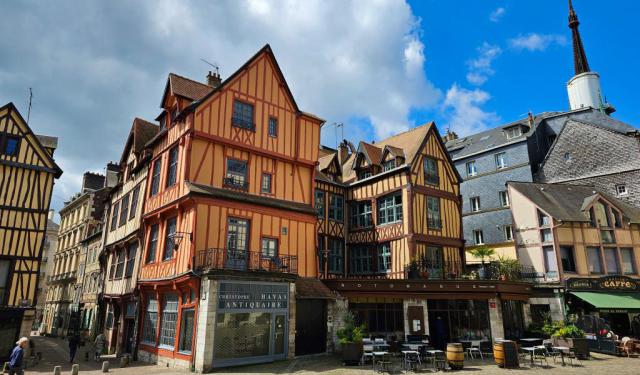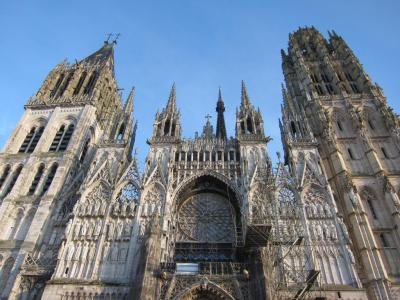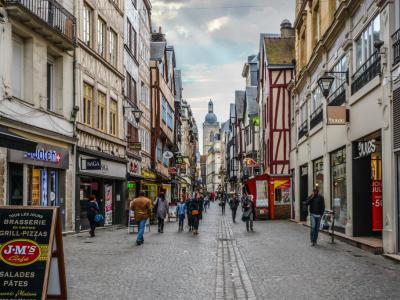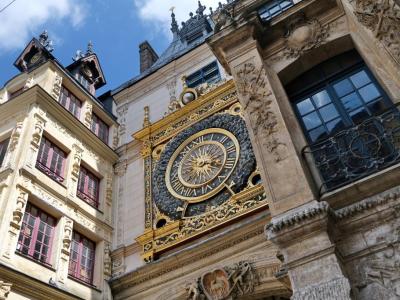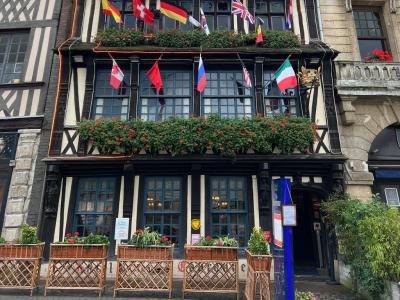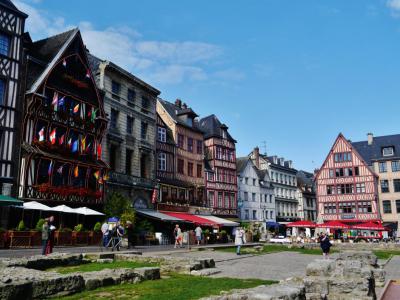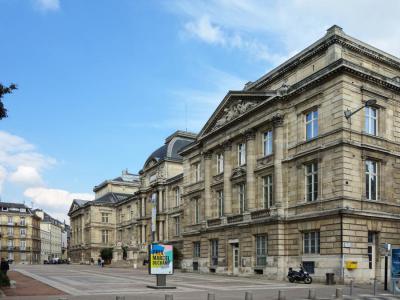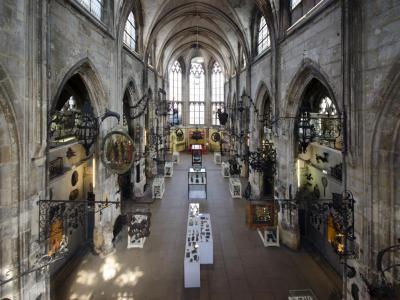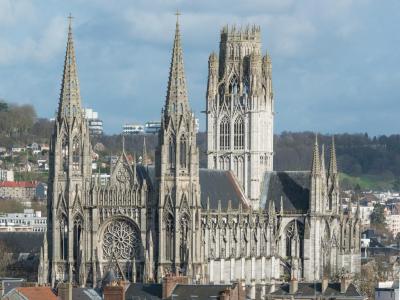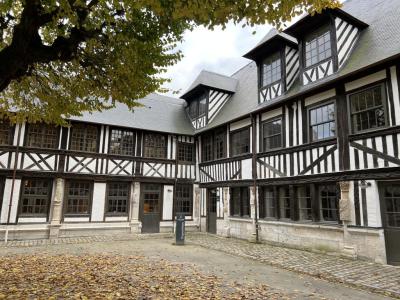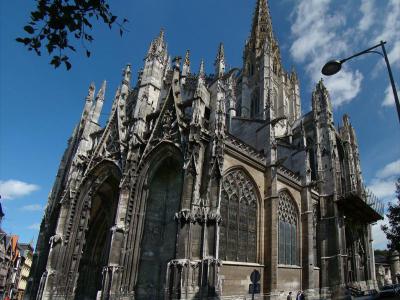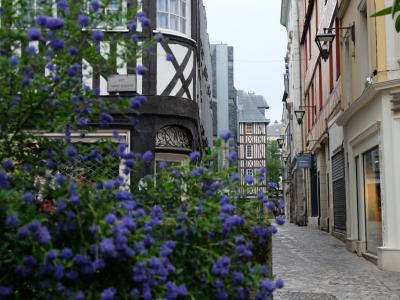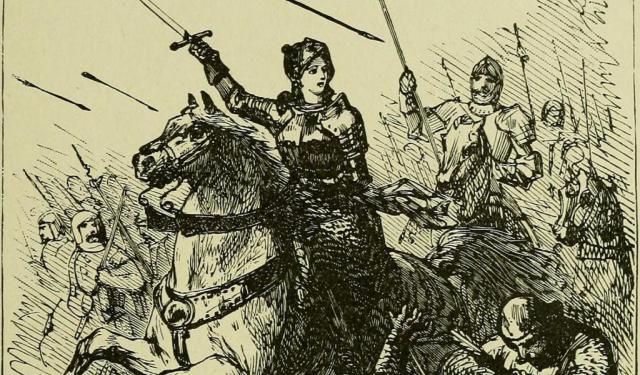Rouen Introduction Walking Tour (Self Guided), Rouen
A proud jewel of the Seine Valley in the picturesque Upper Normandy, France, the city of Rouen has a story dating back centuries. The name "Rouen" stems from the Gaulish-Roman era when the city was known as "Rotomagus." Over time, it has evolved into "Rouen".
During the Middle Ages, Rouen was the seat of the Exchequer of Normandy. It was also one of the capitals of the Anglo-Norman dynasties, which ruled both England and large parts of France from the 11th to the 15th centuries. From the 13th century onwards, the city experienced a remarkable economic boom, thanks in particular to the development of textile factories and river trade.
Claimed by both the French and the English during the Hundred Years' War, it was on Rouen's soil that the legendary heroine Joan of Arc was put on trial and ultimately met her death, on the Old Market Square (Place du Vieux-Marche), in 1431. Severely damaged by the wave of bombing in 1944, the city nevertheless regained its economic dynamism in the post-war period due to its industrial sites and seaport, one of the largest in France.
Endowed with a prestige established during the medieval era, and with a long architectural heritage in its historical monuments, today's Rouen is an important cultural capital. Most of its top attractions lie within the city's pedestrian zone, a charming area of winding medieval lanes and half-timbered houses.
Local highlights include the renowned Museum of Fine Arts (Musée des Beaux-Arts de Rouen), the unique Museum of Wrought Ironwork (Secq des Tournelles museum), and the awe-inspiring Rouen Cathedral, a masterpiece of Gothic architecture whose soaring spires punctuate the sky.
Wandering further, you'll come across the Big Clock Street (Rue du Gros-Horloge), aptly named for the 14th-century astronomical clock that adorns it.
For believers, Rouen's ecclesiastical heritage is equally impressive, with the majestic Saint-Ouen Abbey (Abbaye Saint-Ouen), the haunting Saint Maclou's Courtyard (Aitre Saint-Maclou), and the exquisite Church of Saint Maclou standing as testaments to the city's spiritual legacy.
A stroll through the quaint old streets of Rouen reveals historic places, from the Middle Ages to the modern era, at every turn. So, do come here and discover the magic of this enchanting city to let its timeless charm leave an indelible mark on your heart!
During the Middle Ages, Rouen was the seat of the Exchequer of Normandy. It was also one of the capitals of the Anglo-Norman dynasties, which ruled both England and large parts of France from the 11th to the 15th centuries. From the 13th century onwards, the city experienced a remarkable economic boom, thanks in particular to the development of textile factories and river trade.
Claimed by both the French and the English during the Hundred Years' War, it was on Rouen's soil that the legendary heroine Joan of Arc was put on trial and ultimately met her death, on the Old Market Square (Place du Vieux-Marche), in 1431. Severely damaged by the wave of bombing in 1944, the city nevertheless regained its economic dynamism in the post-war period due to its industrial sites and seaport, one of the largest in France.
Endowed with a prestige established during the medieval era, and with a long architectural heritage in its historical monuments, today's Rouen is an important cultural capital. Most of its top attractions lie within the city's pedestrian zone, a charming area of winding medieval lanes and half-timbered houses.
Local highlights include the renowned Museum of Fine Arts (Musée des Beaux-Arts de Rouen), the unique Museum of Wrought Ironwork (Secq des Tournelles museum), and the awe-inspiring Rouen Cathedral, a masterpiece of Gothic architecture whose soaring spires punctuate the sky.
Wandering further, you'll come across the Big Clock Street (Rue du Gros-Horloge), aptly named for the 14th-century astronomical clock that adorns it.
For believers, Rouen's ecclesiastical heritage is equally impressive, with the majestic Saint-Ouen Abbey (Abbaye Saint-Ouen), the haunting Saint Maclou's Courtyard (Aitre Saint-Maclou), and the exquisite Church of Saint Maclou standing as testaments to the city's spiritual legacy.
A stroll through the quaint old streets of Rouen reveals historic places, from the Middle Ages to the modern era, at every turn. So, do come here and discover the magic of this enchanting city to let its timeless charm leave an indelible mark on your heart!
How it works: Download the app "GPSmyCity: Walks in 1K+ Cities" from Apple App Store or Google Play Store to your mobile phone or tablet. The app turns your mobile device into a personal tour guide and its built-in GPS navigation functions guide you from one tour stop to next. The app works offline, so no data plan is needed when traveling abroad.
Rouen Introduction Walking Tour Map
Guide Name: Rouen Introduction Walking Tour
Guide Location: France » Rouen (See other walking tours in Rouen)
Guide Type: Self-guided Walking Tour (Sightseeing)
# of Attractions: 12
Tour Duration: 2 Hour(s)
Travel Distance: 2.8 Km or 1.7 Miles
Author: DanaOffice
Sight(s) Featured in This Guide:
Guide Location: France » Rouen (See other walking tours in Rouen)
Guide Type: Self-guided Walking Tour (Sightseeing)
# of Attractions: 12
Tour Duration: 2 Hour(s)
Travel Distance: 2.8 Km or 1.7 Miles
Author: DanaOffice
Sight(s) Featured in This Guide:
- Cathedrale Notre-Dame de Rouen (Rouen Cathedral)
- Rue du Gros-Horloge (Street of the Big Clock)
- Gros Horloge (Great Clock)
- La Couronne Restaurant
- Place du Vieux-Marche (Old Market Square)
- Musee des Beaux-Arts de Rouen (Museum of Fine Arts)
- Musee Le Secq des Tournelles (Museum of Wrought Ironwork)
- Place du General-de-Gaulle (General de Gaulle Square)
- Abbaye Saint-Ouen (Saint-Ouen Abbey)
- Aitre Saint-Maclou (Saint-Maclou's Courtyard)
- Eglise Saint-Maclou (Church of Saint-Maclou)
- Rue Saint-Romain (Saint-Romain Street)
1) Cathedrale Notre-Dame de Rouen (Rouen Cathedral) (must see)
Rouen Cathedral is one of the most renowned Gothic cathedrals in France and a masterpiece of medieval architecture. Construction of the cathedral began in the 12th century and continued over several centuries, with various architectural styles incorporated into its design. The cathedral's facade is a striking example of the Flamboyant Gothic style, characterized by intricate stone carvings and delicate tracery. The cathedral features a unique asymmetrical facade with three portals, each adorned with beautifully crafted sculptures depicting scenes from the Bible.
One of the most iconic elements of Rouen Cathedral is its soaring spire, which reaches a height of 151 meters (495 feet). For centuries, it held the title of the tallest building in the world, making it a source of inspiration for countless artists, including Claude Monet, who painted a famous series of canvases capturing the cathedral's changing appearance in different lighting conditions.
Inside the cathedral, visitors can admire its awe-inspiring interior with its rib-vaulted ceilings, elegant stained glass windows, and a magnificent choir. The cathedral also houses several chapels and tombs of historical significance, adding to its cultural richness.
Rouen Cathedral has witnessed numerous historical events, including the crowning of several French kings and the trial and execution of Joan of Arc in the 15th century.
One of the most iconic elements of Rouen Cathedral is its soaring spire, which reaches a height of 151 meters (495 feet). For centuries, it held the title of the tallest building in the world, making it a source of inspiration for countless artists, including Claude Monet, who painted a famous series of canvases capturing the cathedral's changing appearance in different lighting conditions.
Inside the cathedral, visitors can admire its awe-inspiring interior with its rib-vaulted ceilings, elegant stained glass windows, and a magnificent choir. The cathedral also houses several chapels and tombs of historical significance, adding to its cultural richness.
Rouen Cathedral has witnessed numerous historical events, including the crowning of several French kings and the trial and execution of Joan of Arc in the 15th century.
2) Rue du Gros-Horloge (Street of the Big Clock) (must see)
The Street of the Big Clock is renowned for its stunning medieval clock, which gives the street its name, and its vibrant atmosphere. This ornate timepiece features a large, gilded clock face adorned with intricate details and Roman numerals. The clock mechanism is housed in a beautiful Renaissance-era arch, complete with decorative sculptures.
As visitors stroll along the Street of the Big Clock, they are enveloped in the enchanting ambiance of a bygone era. The street is lined with historic half-timbered houses adorned with colorful facades, traditional French bistros, quaint shops, and charming cafes. The architecture here reflects the medieval and Renaissance influences that have shaped Rouen's history.
The Street of the Big Clock is also a hub of activity. It serves as a central point for locals and tourists alike to gather, dine, shop, and soak in the city's vibrant atmosphere. The street often hosts street performances, art exhibitions, and various cultural events, adding to its lively character.
The location of Street of the Big Clock is strategic, connecting the Place du Vieux-Marché, where Joan of Arc was famously executed, to the stunning Rouen Cathedral.
As visitors stroll along the Street of the Big Clock, they are enveloped in the enchanting ambiance of a bygone era. The street is lined with historic half-timbered houses adorned with colorful facades, traditional French bistros, quaint shops, and charming cafes. The architecture here reflects the medieval and Renaissance influences that have shaped Rouen's history.
The Street of the Big Clock is also a hub of activity. It serves as a central point for locals and tourists alike to gather, dine, shop, and soak in the city's vibrant atmosphere. The street often hosts street performances, art exhibitions, and various cultural events, adding to its lively character.
The location of Street of the Big Clock is strategic, connecting the Place du Vieux-Marché, where Joan of Arc was famously executed, to the stunning Rouen Cathedral.
3) Gros Horloge (Great Clock) (must see)
Dating back to the late 14th century, the Great Clock has become a symbol of the city's rich heritage. As you approach the clock, you'll be captivated by the ornate arch and the beautifully carved wooden belfry.
Originally constructed without a dial, this extraordinary timekeeping mechanism showcased a unique design where one revolution of the hour-hand represented a full twenty-four hours. Crafted from wrought iron, the clock's movement is a monumental piece of craftsmanship, renowned for its size and complexity. In fact, it's considered one of the largest surviving clock mechanisms in existence, dwarfing even the renowned Wells Cathedral clock.
Another fascinating feature of the Great Clock is its depiction of the days of the week, each accompanied by allegorical symbols. These representations provide a unique insight into the cultural and symbolic significance attached to each day.
The clock facade is a work of art in itself, featuring a golden sun with 24 rays set against a starry blue background. The dial of the clock is equally captivating, measuring an impressive 2.5 meters (250 cm) in diameter. Within the dial, one can observe the phases of the moon displayed in the oculus of the upper part, completing a full rotation over 29 days.
While the clock's original movement is no longer functional, it continues to captivate visitors with its historical significance and artistic beauty. What makes the Great Clock even more fascinating is its multifaceted history. Originally, it served as a city gate, controlling access to the medieval town. Over time, it evolved into a symbol of municipal authority and civic pride.
Originally constructed without a dial, this extraordinary timekeeping mechanism showcased a unique design where one revolution of the hour-hand represented a full twenty-four hours. Crafted from wrought iron, the clock's movement is a monumental piece of craftsmanship, renowned for its size and complexity. In fact, it's considered one of the largest surviving clock mechanisms in existence, dwarfing even the renowned Wells Cathedral clock.
Another fascinating feature of the Great Clock is its depiction of the days of the week, each accompanied by allegorical symbols. These representations provide a unique insight into the cultural and symbolic significance attached to each day.
The clock facade is a work of art in itself, featuring a golden sun with 24 rays set against a starry blue background. The dial of the clock is equally captivating, measuring an impressive 2.5 meters (250 cm) in diameter. Within the dial, one can observe the phases of the moon displayed in the oculus of the upper part, completing a full rotation over 29 days.
While the clock's original movement is no longer functional, it continues to captivate visitors with its historical significance and artistic beauty. What makes the Great Clock even more fascinating is its multifaceted history. Originally, it served as a city gate, controlling access to the medieval town. Over time, it evolved into a symbol of municipal authority and civic pride.
4) La Couronne Restaurant
Established in 1345, La Couronne holds the distinction of being one of the oldest restaurants in the country, making it a cherished culinary institution with a rich history and reputation for excellence.
Housed in a building that exudes historic charm, La Couronne's interior is a blend of classic elegance and timeless appeal. Its architecture and decor create an ambiance that transports guests to a bygone era, providing a memorable dining experience.
La Couronne is celebrated for its gourmet French cuisine, showcasing the finest flavors of the region. The menu features a delectable array of traditional and contemporary French dishes prepared with precision and artistry. From escargot to coq au vin, every dish is a culinary masterpiece.
Over the centuries, La Couronne has welcomed a host of notable guests, including literary luminaries like Victor Hugo and Gustave Flaubert. It features a charming dining room on the first floor adorned with portraits of notable figures. In a memorable moment in 1948, the restaurant had the privilege of serving chef and author Julia Child her inaugural French meal. This experience is said to have ignited her lifelong passion for advocating French cuisine.
Housed in a building that exudes historic charm, La Couronne's interior is a blend of classic elegance and timeless appeal. Its architecture and decor create an ambiance that transports guests to a bygone era, providing a memorable dining experience.
La Couronne is celebrated for its gourmet French cuisine, showcasing the finest flavors of the region. The menu features a delectable array of traditional and contemporary French dishes prepared with precision and artistry. From escargot to coq au vin, every dish is a culinary masterpiece.
Over the centuries, La Couronne has welcomed a host of notable guests, including literary luminaries like Victor Hugo and Gustave Flaubert. It features a charming dining room on the first floor adorned with portraits of notable figures. In a memorable moment in 1948, the restaurant had the privilege of serving chef and author Julia Child her inaugural French meal. This experience is said to have ignited her lifelong passion for advocating French cuisine.
5) Place du Vieux-Marche (Old Market Square)
The Old Market Square is a historic and vibrant square known for its rich history, architecture, and cultural significance.
One of the most prominent features of Old Market Square is the Church of Saint-Jeanne-d’Arc, a stunning modern church that serves as a memorial to Joan of Arc. This unique architectural masterpiece was designed by Louis Arretche and stands as a symbol of the city's connection to the iconic historical figure.
The square is also famous for its open-air market, which has been a tradition in Rouen for centuries. Visitors can explore the market stalls, where local vendors offer a wide range of products, including fresh produce, artisanal goods, clothing, and more. It's a fantastic place to immerse yourself in the local culture and taste some of the region's culinary delights.
One of the most significant historical events associated with Old Market Square is the execution of Joan of Arc. On May 30, 1431, Joan of Arc, just 19 years old, met her tragic fate as she was executed by burning at the stake. This solemn event unfolded in the historic Old Market Square, bearing witness to a significant gathering of onlookers. Among the spectators, some had assembled at the square's most ancient inn, recognized today as La Couronne. Today, a monument commemorating her memory can be found in the square.
One of the most prominent features of Old Market Square is the Church of Saint-Jeanne-d’Arc, a stunning modern church that serves as a memorial to Joan of Arc. This unique architectural masterpiece was designed by Louis Arretche and stands as a symbol of the city's connection to the iconic historical figure.
The square is also famous for its open-air market, which has been a tradition in Rouen for centuries. Visitors can explore the market stalls, where local vendors offer a wide range of products, including fresh produce, artisanal goods, clothing, and more. It's a fantastic place to immerse yourself in the local culture and taste some of the region's culinary delights.
One of the most significant historical events associated with Old Market Square is the execution of Joan of Arc. On May 30, 1431, Joan of Arc, just 19 years old, met her tragic fate as she was executed by burning at the stake. This solemn event unfolded in the historic Old Market Square, bearing witness to a significant gathering of onlookers. Among the spectators, some had assembled at the square's most ancient inn, recognized today as La Couronne. Today, a monument commemorating her memory can be found in the square.
6) Musee des Beaux-Arts de Rouen (Museum of Fine Arts) (must see)
The history of the Museum of Fine Arts dates back to the 19th century when it was officially opened in 1801. Over the years, it has grown significantly and is now housed in a beautiful neo-classical building, which itself is a work of art. The museum's collection is divided into several sections, each showcasing different artistic styles and periods.
One of the highlights of the Museum of Fine Arts is its extensive collection of European paintings, which includes works by renowned artists such as Claude Monet, Pierre-Auguste Renoir, and Camille Pissarro. The collection covers a wide range of styles, from the Renaissance to the modern era, making it a treasure trove for art enthusiasts.
In addition to its paintings, the museum also features an impressive collection of sculptures, ceramics, and decorative arts. Visitors can explore various artistic movements, from classical to impressionist, and gain insight into the evolution of art over the centuries.
One of the highlights of the Museum of Fine Arts is its extensive collection of European paintings, which includes works by renowned artists such as Claude Monet, Pierre-Auguste Renoir, and Camille Pissarro. The collection covers a wide range of styles, from the Renaissance to the modern era, making it a treasure trove for art enthusiasts.
In addition to its paintings, the museum also features an impressive collection of sculptures, ceramics, and decorative arts. Visitors can explore various artistic movements, from classical to impressionist, and gain insight into the evolution of art over the centuries.
7) Musee Le Secq des Tournelles (Museum of Wrought Ironwork)
Housed in the old disused Saint-Laurent Church, the Museum of Wrought Ironwork boasts an extensive and diverse collection of wrought iron objects and artifacts, making it one of the most specialized museums of its kind in the world.
Originally built as a place of worship, Saint-Laurent Church reflects the architectural styles of the period it was constructed, showcasing elements of Gothic and medieval design. Its stone structure and intricate details are characteristic of religious buildings from that era. Over time, as the church ceased to function as a place of worship, it found new life as the Museum of Wrought Ironwork.
The museum's history dates back to the late 19th century when the Le Secq des Tournelles family, passionate about preserving the heritage of wrought iron craftsmanship, donated their private collection to the city of Rouen. The museum officially opened its doors in 1921, and since then, it has been a treasure trove for ironwork enthusiasts, artists, historians, and visitors interested in exploring this unique art form.
Visitors to the Museum of Wrought Ironwork can admire a wide range of wrought iron creations, including decorative gates, balconies, locks, keys, tools, and architectural elements. The collection spans various historical periods, showcasing the evolution of ironwork techniques and styles from the Middle Ages to the 19th century.
One of the museum's standout features is its remarkable display of intricate and ornate ironwork designs, which demonstrate the craftsmanship and artistic skills of ironworkers from different eras. The objects on exhibit not only serve as functional pieces but also as works of art, highlighting the beauty and versatility of wrought iron.
Originally built as a place of worship, Saint-Laurent Church reflects the architectural styles of the period it was constructed, showcasing elements of Gothic and medieval design. Its stone structure and intricate details are characteristic of religious buildings from that era. Over time, as the church ceased to function as a place of worship, it found new life as the Museum of Wrought Ironwork.
The museum's history dates back to the late 19th century when the Le Secq des Tournelles family, passionate about preserving the heritage of wrought iron craftsmanship, donated their private collection to the city of Rouen. The museum officially opened its doors in 1921, and since then, it has been a treasure trove for ironwork enthusiasts, artists, historians, and visitors interested in exploring this unique art form.
Visitors to the Museum of Wrought Ironwork can admire a wide range of wrought iron creations, including decorative gates, balconies, locks, keys, tools, and architectural elements. The collection spans various historical periods, showcasing the evolution of ironwork techniques and styles from the Middle Ages to the 19th century.
One of the museum's standout features is its remarkable display of intricate and ornate ironwork designs, which demonstrate the craftsmanship and artistic skills of ironworkers from different eras. The objects on exhibit not only serve as functional pieces but also as works of art, highlighting the beauty and versatility of wrought iron.
8) Place du General-de-Gaulle (General de Gaulle Square)
General de Gaulle Square, often referred to simply as City Hall Square is the central hub for both locals and tourists. The square is named after Charles de Gaulle, a prominent French general and statesman.
The City Hall of Rouen is a striking building that dominates one side of the square. It boasts impressive architecture, featuring a combination of Gothic and Renaissance styles. The City Hall is not only an administrative center but also a historical landmark. Visitors can admire its façade and occasionally explore its interior during special events or guided tours.
A Monument to Napoleon I is situated in the General de Gaulle Square. It pays tribute to Napoleon Bonaparte, one of France's most iconic figures. The monument features a bronze equestrian statue of Napoleon on horseback. He is depicted in military attire, a characteristic hat, and a pose that exudes authority and leadership. The statue captures the essence of Napoleon as a military commander.
The square is surrounded by elegant buildings, cafes, shops, and restaurants, making it an ideal spot for people-watching while sipping on a cup of coffee or enjoying a meal.
The City Hall of Rouen is a striking building that dominates one side of the square. It boasts impressive architecture, featuring a combination of Gothic and Renaissance styles. The City Hall is not only an administrative center but also a historical landmark. Visitors can admire its façade and occasionally explore its interior during special events or guided tours.
A Monument to Napoleon I is situated in the General de Gaulle Square. It pays tribute to Napoleon Bonaparte, one of France's most iconic figures. The monument features a bronze equestrian statue of Napoleon on horseback. He is depicted in military attire, a characteristic hat, and a pose that exudes authority and leadership. The statue captures the essence of Napoleon as a military commander.
The square is surrounded by elegant buildings, cafes, shops, and restaurants, making it an ideal spot for people-watching while sipping on a cup of coffee or enjoying a meal.
9) Abbaye Saint-Ouen (Saint-Ouen Abbey)
Saint-Ouen Abbey, officially known as the Abbey of Saint Peter and Saint Ouen, is renowned for its stunning church and significant contributions to the cultural and religious heritage of Rouen.
The abbey's history traces its origins to the 7th century when it was founded as a simple monastery dedicated to Saint Peter. Over the centuries, it evolved and expanded in size and importance. The impressive abbey church, dedicated to both Saint Peter and Saint Ouen, was constructed between the 13th and 16th centuries and stands as a masterpiece of Gothic architecture. Its soaring nave, intricate stained glass windows, and ornate vaulted ceilings are awe-inspiring examples of the period's architectural prowess.
The abbey church of Saint Ouen is particularly renowned for its magnificent organ, one of the largest in France. The exquisite woodwork, intricate carvings, and grandiose pipe facade make it a focal point of the abbey's interior.
On May 24th, Joan was brought to a platform erected in the cemetery adjacent to Saint-Ouen Church. She was given an ultimatum: either sign a document renouncing her visions and commit to no longer wearing soldiers' attire, or face immediate execution by burning. Confronted with the imminent threat to her life, Joan reluctantly consented to relinquish her clothing and put her signature on the abjuration document.
The abbey's history traces its origins to the 7th century when it was founded as a simple monastery dedicated to Saint Peter. Over the centuries, it evolved and expanded in size and importance. The impressive abbey church, dedicated to both Saint Peter and Saint Ouen, was constructed between the 13th and 16th centuries and stands as a masterpiece of Gothic architecture. Its soaring nave, intricate stained glass windows, and ornate vaulted ceilings are awe-inspiring examples of the period's architectural prowess.
The abbey church of Saint Ouen is particularly renowned for its magnificent organ, one of the largest in France. The exquisite woodwork, intricate carvings, and grandiose pipe facade make it a focal point of the abbey's interior.
On May 24th, Joan was brought to a platform erected in the cemetery adjacent to Saint-Ouen Church. She was given an ultimatum: either sign a document renouncing her visions and commit to no longer wearing soldiers' attire, or face immediate execution by burning. Confronted with the imminent threat to her life, Joan reluctantly consented to relinquish her clothing and put her signature on the abjuration document.
10) Aitre Saint-Maclou (Saint-Maclou's Courtyard)
Saint-Maclou's Courtyard, often referred to as the "Skeletons' Courtyard" due to its eerie and macabre associations with the Black Death, is not your typical tourist attraction but rather a remarkable piece of Rouen's history and architecture.
Saint-Maclou's Courtyard was originally a burial ground during the medieval period. In the 14th century, the Black Death swept through Europe, including Rouen, resulting in a devastating loss of life. To accommodate the increasing number of victims, the site was transformed into a mass burial ground.
One of the most striking features of Saint-Maclou's is its courtyard, which is surrounded by a series of timber-framed buildings adorned with intricate carvings. These carvings include macabre and death-related motifs, such as skeletons, skulls, and winged death heads. These decorations serve as a chilling reminder of the plague's impact on the city.
Today, Saint-Maclou's Courtyard has been preserved and serves as a historical monument and museum. Visitors can explore the courtyard and the buildings, which house various exhibitions and displays related to the site's history and the Black Death's devastating effects. The museum provides valuable insights into Rouen's past, particularly during this dark period.
Saint-Maclou's Courtyard was originally a burial ground during the medieval period. In the 14th century, the Black Death swept through Europe, including Rouen, resulting in a devastating loss of life. To accommodate the increasing number of victims, the site was transformed into a mass burial ground.
One of the most striking features of Saint-Maclou's is its courtyard, which is surrounded by a series of timber-framed buildings adorned with intricate carvings. These carvings include macabre and death-related motifs, such as skeletons, skulls, and winged death heads. These decorations serve as a chilling reminder of the plague's impact on the city.
Today, Saint-Maclou's Courtyard has been preserved and serves as a historical monument and museum. Visitors can explore the courtyard and the buildings, which house various exhibitions and displays related to the site's history and the Black Death's devastating effects. The museum provides valuable insights into Rouen's past, particularly during this dark period.
11) Eglise Saint-Maclou (Church of Saint-Maclou)
The Church of Saint-Maclou was constructed between the late 15th and early 16th centuries. Its intricate and ornate facade, characterized by delicate stonework and intricate carvings, is a remarkable example of Flamboyant Gothic architecture.
One of the most striking features of the Church of Saint-Maclou is its tall and elegant spire, which rises gracefully into the sky. The church's exterior is adorned with numerous statues and sculptures, depicting religious figures and scenes from the Bible.
Inside the church, visitors can marvel at the impressive stained glass windows that bathe the interior in colorful light. These windows depict various biblical stories and saints, adding to the overall beauty and spiritual ambiance of the church. The vaulted ceilings and intricately carved wooden choir stalls are other highlights of the interior, showcasing the architectural and artistic achievements of the era.
One of the most striking features of the Church of Saint-Maclou is its tall and elegant spire, which rises gracefully into the sky. The church's exterior is adorned with numerous statues and sculptures, depicting religious figures and scenes from the Bible.
Inside the church, visitors can marvel at the impressive stained glass windows that bathe the interior in colorful light. These windows depict various biblical stories and saints, adding to the overall beauty and spiritual ambiance of the church. The vaulted ceilings and intricately carved wooden choir stalls are other highlights of the interior, showcasing the architectural and artistic achievements of the era.
12) Rue Saint-Romain (Saint-Romain Street)
Rue Saint-Romain boasts a rich history dating back centuries. It is named after Saint Romain, the patron saint of Rouen.
The street is lined with a diverse range of architectural styles, reflecting different periods in Rouen's history. Visitors can admire well-preserved medieval buildings, charming half-timbered houses, and elegant facades that showcase the city's architectural evolution.
Saint-Romain Street also is home to numerous shops, boutiques, cafes, and restaurants. Visitors can explore local shops, savor delicious French cuisine, or simply take a leisurely stroll to soak in the ambiance.
At the northern end of Saint-Romain Street, you'll find the stunning Saint-Maclou Church. This Gothic masterpiece is renowned for its intricate facade, exquisite stained glass windows, and its significance as a historical and religious site.
A must-see on Rue Saint-Romain is the portal of the Booksellers at number 3. This architectural gem, showcasing Flamboyant Gothic design from the late 13th century, was built to provide the canons with direct access to the cathedral via Saint-Romain Street.
The street is lined with a diverse range of architectural styles, reflecting different periods in Rouen's history. Visitors can admire well-preserved medieval buildings, charming half-timbered houses, and elegant facades that showcase the city's architectural evolution.
Saint-Romain Street also is home to numerous shops, boutiques, cafes, and restaurants. Visitors can explore local shops, savor delicious French cuisine, or simply take a leisurely stroll to soak in the ambiance.
At the northern end of Saint-Romain Street, you'll find the stunning Saint-Maclou Church. This Gothic masterpiece is renowned for its intricate facade, exquisite stained glass windows, and its significance as a historical and religious site.
A must-see on Rue Saint-Romain is the portal of the Booksellers at number 3. This architectural gem, showcasing Flamboyant Gothic design from the late 13th century, was built to provide the canons with direct access to the cathedral via Saint-Romain Street.
Walking Tours in Rouen, France
Create Your Own Walk in Rouen
Creating your own self-guided walk in Rouen is easy and fun. Choose the city attractions that you want to see and a walk route map will be created just for you. You can even set your hotel as the start point of the walk.
Joan of Arc Historical Sites
Joan of Arc, a patron saint of France, is honored as a defender of the French nation for her role in the 15th-century siege of Orléans that marked a turning point of the Hundred Years' War between France and England. The memory of Joan is engraved in various heritage sites and urban spaces throughout Rouen, the town in which she met her death.
The historic Old Market Square (Place du... view more
Tour Duration: 1 Hour(s)
Travel Distance: 1.8 Km or 1.1 Miles
The historic Old Market Square (Place du... view more
Tour Duration: 1 Hour(s)
Travel Distance: 1.8 Km or 1.1 Miles
The Most Popular Cities
/ view all
